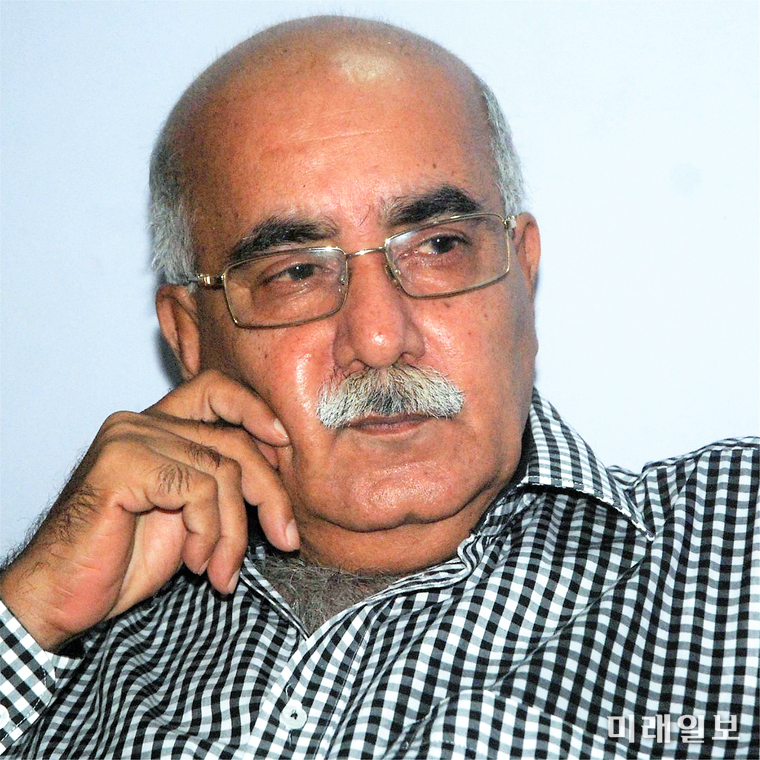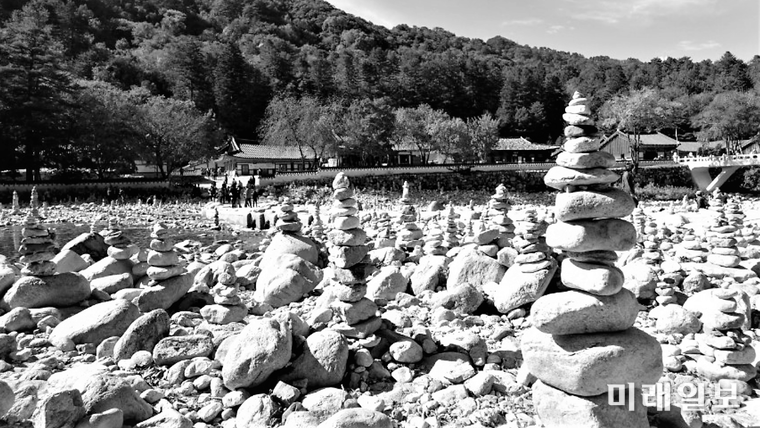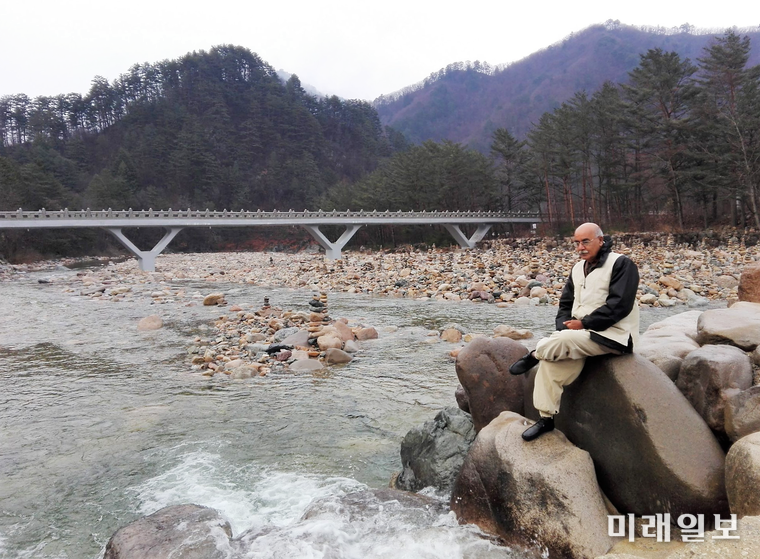 (서울=미래일보) 나시르 아이자즈(Nasir Aijaz) = 내가 한국을 방문한 2008년의 쌀쌀한 겨울이었다. 한국의 설악산 뒤로 해가 거의 지고 황혼이 사방을 뒤덮고 있었다. 산 전체에 울창한 숲이 펼쳐져 있었고, 꼬불꼬불한 길을 따라 흐르는 시냇물 소리와 유서 깊은 백담사 사찰의 모양과 구조물을 보고 있었다.
(서울=미래일보) 나시르 아이자즈(Nasir Aijaz) = 내가 한국을 방문한 2008년의 쌀쌀한 겨울이었다. 한국의 설악산 뒤로 해가 거의 지고 황혼이 사방을 뒤덮고 있었다. 산 전체에 울창한 숲이 펼쳐져 있었고, 꼬불꼬불한 길을 따라 흐르는 시냇물 소리와 유서 깊은 백담사 사찰의 모양과 구조물을 보고 있었다.
나는 작은 자갈 탑을 세우고 개울 바닥에 앉아 있는 몇몇 사람들을 바라보며 고요한 분위기에 매료되어 서 있었다. 나는 돌탑에 호기심이 생겨서 그 사람들에게 다가가 탑처럼 자갈을 쌓아 놓은 의미에 관하여 물었다.
비록 우리는 서로의 언어를 잘 이해하지 못했지만, 보편적인 언어인 몸짓으로 그것이 그들의 소원을 비는 기도의 방법이라는 것을 알게 해주었다. 곧, 그들은 모두 도보로 계곡을 떠났고, 지는 밤의 어둠이 빠르게 그 지역을 덮고 있었다.
강렬한 고요함을 느끼며 혼자 서서 '소망의 돌탑'이라고 부르는 수천 개의 돌탑이 시냇물 바닥에 펼쳐져 있는 것을 바라보았다. 나는 2007년에 백담사를 처음 방문했고, 아시아기자협회(AJA) 대표단을 위해 주임 스님이 주최한 사찰에서 '불교 오찬'을 경험했지만, AJA가 주최한 두 번째 방문에서는 사찰에서 숙박하며 '소망의 돌탑'을 관람할 기회가 있었다.
‘신앙 치유의 독특한 방법’이라는 생각을 하며 나의 조국 파키스탄에서도 수피(신비주의)성자의 사원을 방문하여 신앙 치유를 하려 하는 것이 머릿속에서 떠올랐다. 수피즘은 포용력이 커서 이슬람교도든, 힌두교이든, 다른 종교나 믿음을 가진 사람이든 상관없이 허용한다.
주로 파키스탄, 인도, 방글라데시, 네팔뿐만 아니라 일부 다른 이웃 국가에서 다른 종교를 가진 대다수 사람이 사원(사람들이 경건하다고 '믿는' 사람들의 무덤)을 방문하고 '경건한' 영혼에게 건강을 빈다.
자녀의 출생, 재물, 하느님만이 줄 수 있는 것들을 빈다. 이 사람들은 그들이 정말로 죽은 자들에게 이런 것들을 요구하는 것이 아니라 그들을 하느님과의 중보자(仲保者)로 본다고 주장한다. 그들의 믿음은 경건한 자들이 살아 있을 때 이 세상에서 잘했기 때문에 이제 그들은 부르짖는 자들을 위해 하느님과 함께 중보자 역할을 할 수 있는 위치에 있다는 것이다. 사당을 순례하는 동안 사람들은 나뭇가지에 색깔 있는 실이나 천 조각을 묶고 기도를 드리며, 북을 치면서 신비로운 춤인 다말(Dhamal)에 참여한다. 사당 근처의 한적한 곳에서 몇 시간 동안 명상하는 것도 인도-파키스탄 지역의 신앙 치유의 한 방법이다.
사당을 순례하는 동안 사람들은 나뭇가지에 색깔 있는 실이나 천 조각을 묶고 기도를 드리며, 북을 치면서 신비로운 춤인 다말(Dhamal)에 참여한다. 사당 근처의 한적한 곳에서 몇 시간 동안 명상하는 것도 인도-파키스탄 지역의 신앙 치유의 한 방법이다.
신앙 치유는 영적 및 육체적 치유에 신의 개입을 끌어내는 것으로 설명하는 기도와 몸짓의 의식적인 관행이다. 신자들은 질병과 장애의 치유가 신의 존재와 권능을 자극하는 기도, 또는 기타 의식을 통해 종교적 신앙으로 이루어질 수 있다고 주장한다.
그러한 신의 개입에 대한 믿음은 종교적 믿음에서 비롯된다. 믿음이 실명, 청각장애, 암, AIDS, 발달 장애, 정신 장애, 빈혈, 관절염, 티눈, 언어 결함, 다발성 경화증, 피부 발진, 전신 마비 및 다양한 부상을 치료할 수 있다는 주장이 있다.
기적적인 회복은 일반적으로 신앙 치유로 분류되는 많은 기술에 기인한다. 여기에는 기도, 종교 성지 방문 또는 단순히 최고의 존재에 대한 강한 믿음이 포함될 수 있다. 신앙 치유는 영적, 초자연적 또는 초자연적 사건으로 분류될 수 있으며, 때에 따라 신앙 치유에 대한 믿음은 마술적 사고로 분류될 수 있다.
미국 암 협회는 "이용 가능한 과학적 증거는 신앙 치유가 실제로 신체적 질병을 치료할 수 있다는 주장을 뒷받침하지 않는다"고 말한다.
개인적으로 나는 많은 교육을 받은 사람들이 영적 만족을 위해 호화로운 도시 생활을 포기하고 신사에서 몇 달을 보낸다는 것을 알고 있지만, 불행히도 이 지역 전체에는 순례자의 믿음을 이용하는 가짜 신앙 치료사도 많이 있다는 것을 알기에 나는 항상 그런 곳을 방문하는 것을 피했다. 하지만 사찰은 또 다른 성격을 보여주어서 많은 매력을 느꼈다.
AJA는 2017년 4월 1일 나에게 중앙아시아, 남아시아, 동아시아의 여러 나라에서 온 여러 친구와 함께 백담사에서 1박을 주선하면서 세 번째 기회를 주었다. 사찰의 여러 구역을 둘러보고, 강연과 명상을 하고, 스님이 이끄는 촛불 행렬에 참여하여 수심교까지 가는 것 외에도 소원의 돌탑을 보기 위해 하천 바닥으로 이동했다.
백담사로 가는 길에 수심교 양쪽과 아래 계곡에서 소원을 비는 탑의 이색적인 풍경을 만났다.
"여름 장마철에 이 탑들은 유실되지만, 더 많은 탑이 솟아오릅니다."라고 여승이 말했다.
"그것들은 백담사 절경의 일부분이다. 수심교에서 바라보는 눈 덮인 설악산은 연꽃 봉오리를 연상시킨다. 석탑은 꽃의 수술처럼 보인다"고 설명했다.
소원을 비는 돌탑은 순수한 마음을 가진 사람만이 볼 수 있다고 한다. 가장 높은 곳에 있는 석탑에 부처의 '사리'(인체를 의미하는 산스크리트어 사리르. 여기에서는 부처의 유품으로 해석)가 설악산에서 도보로 6시간 거리에 있는데 신도들이 가장 많이 찾는 곳이다.
4월 2일 오전 백담사를 나서며 소원석탑을 다시 바라보며 물질세계에서 벗어나 내면의 영적 만족을 얻을 수 있는 곳이라는 확신과 감탄을 하였다.
- 번역 : 강병철 시인(정치학 박사)
 Wishing Stone Towers: A unique way of faith-healing and meditation
Wishing Stone Towers: A unique way of faith-healing and meditation
By Nasir Aijaz
It was chilling winter of 2008. The sun had almost set behind the Korea’s Mt. Seoraksan and the dusk had enveloped the entire area – the thick forest spread all over the mountain, the stream flowing down with sounds resembling to musical notes along the curly track and the structures of historic Baekdamsa Temple. I stood mesmerized by the serenity of the ambiance gazing at some people sitting in the bed of stream erecting small towers of pebbles. The curiosity took me close to those people to inquire about placing the pebbles in Pagoda style. Although we didn’t understand each other’s language, but the universal language of signs helped me to know that this was the way of praying for realization of their wishes. Soon, they all left down the valley by foot, as the darkness of falling night was fast covering the area into its arms.
With intense feeling of calmness, I stood there alone looking at thousands of stone towers, locally called as 'Wishing Stone Towers', spread all over the stream bed. I had first visited the Baekdamsa Temple in 2007 and had experienced a 'Buddhist Lunch' at the temple hosted by the Chief Monk for the delegates of Asia Journalists Association (AJA) but the second visit again organized by AJA included a night stay at temple, which provided opportunity to observe 'Wishing Stone Towers'.
'A unique way of faith-healing' I thought, which took me back to my country-Pakistan where the people use to visit shrines of Sufi (Mystic) saints for the same purpose, as the Sufism offers more space to the people – be it a Muslim, Hindu or hailing from any other religion or faith. Majority of people from different religions, mostly in Pakistan, India, Bangladesh and Nepal as well as some other neighboring countries, visit shrines (of those whom people 'believe' were pious) and ask the souls of the 'pious' for health, children, wealth, and things that only God can provide. These people claim that they're really not asking the dead for these things, but using them as intercessors with God. Their belief is that because the pious did well in this world when they were alive, they are now in a position to act as intercessors with God for those who invoke them. During their pilgrimage to the shrines, the people use to tie colored threads or strips of cloth to the tree branches and offer prayers besides taking part in Dhamal, the mystic dance at the drum beating. The hours-long meditation at the secluded places near the shrines is also part of the faith-healing in Indo-Pakistan region.
Faith healing is the ritualistic practice of prayer and gestures that are claimed to elicit divine intervention in spiritual and physical healing. Believers assert that the healing of disease and disability can be brought about by religious faith through prayer and/or other rituals that, according to adherents, stimulate a divine presence and power. Belief in such divine intervention is derived from religious belief.
There have been claims that faith can cure blindness, deafness, cancer, AIDS, developmental disorders, mental disorders, anemia, arthritis, corns, defective speech, multiple sclerosis, skin rashes, total body paralysis, and various injuries. Miraculous recoveries have been attributed to many techniques commonly classified as faith healing. It can involve prayer, a visit to a religious shrine, or simply a strong belief in a supreme being.
Faith healing can be classified as a spiritual, supernatural, or paranormal event, and, in some cases, belief in faith healing can be classified as magical thinking. The American Cancer Society states "available scientific evidence does not support claims that faith healing can actually cure physical ailments."
Personally, I know many of the well-educated people, who spent several months at shrines abandoning their luxurious city life for spiritual satisfaction, but unfortunately, this entire region has also lots of the fake faith-healers who use to exploit the beliefs of pilgrims for their mileage, and for this reason, I always avoided visiting such places. However, the Buddhist temples presented a different character, which attracted me a lot.
The AJA offered me a third opportunity on April 01, 2017 when it arranged a night stay at Baekdamsa Temple along with several other friends from different countries of Middle, South, Central and East Asia. Besides visit to various sections of Temple Complex, holding lectures, meditation session and taking part in candle-light procession, led by a nun, up to Susimgyo Bridge, we were also taken to the stream bed for witnessing the Wishing Stone Towers.
We came across the unique scene of Wishing Stone Towers in the valley beneath and on both sides of Susimgyo Bridge on the way to Baekdamsa Temple. "In rainy season of summer, these towers get washed away, yet more towers spring up," the nun told.
"They are famous part of the landscape of Baekdamsa. The snowy mountain of Seorak, seen from Susimgyo Bridge, reminds you of lotus buds. The stone towers look like stamens," she briefed.
It is said that the wishing stone towers can only be seen by the people with a pure heart. The believers use to come here for erecting the pagoda-shaped stone towers, as Buddha’s ‘sarira’ (Sanskrit language word for Buddha’s remains) are placed at a stone pagoda located at highest point of Seoraksan Mountain, at a distance of six-hour walk, and is the most-visited place for believers.
While leaving the Baekdamsa Temple on the morning of April 02, I gazed again at the Wishing Stone Towers in admiration and conviction that this place offers a lot to get away from the materialist world and achieving inner spiritual satisfaction.
__________________
Nasir Aijaz is a Karachi-based senior journalist and author of nine books and hundreds of articles on language, culture, literature and history.
i24@daum.net
